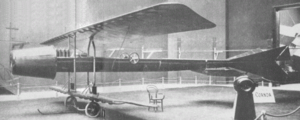Coandă-1910
| Coandă-1910 | |
|---|---|
 |
|
| Coandă-1910 at the 1910 Paris Flight Salon | |
| Role | Experimental |
| National origin | Romania/France |
| Manufacturer | Henri Coandă |
| Number built | 1 |
The Coandă-1910, designed by Romanian inventor Henri Coandă, was an unconventional sesquiplane aircraft powered by a ducted fan. Called the "turbo-propulseur" by Coandă, its experimental engine consisted of a conventional piston engine driving a multi-bladed centrifugal blower which exhausted into a duct. The unusual aircraft attracted attention at the Second International Aeronautical Exhibition in Paris in October 1910, being the only exhibit without a propeller, but the aircraft was not displayed afterwards and it fell from public awareness. Coandă used a similar turbo-propulseur to drive a snow sledge, but he did not develop it further for aircraft.
Decades later, after the practical demonstration of motorjets and turbojets, Coandă began to tell various conflicting stories about how his early experiments were precursors to the jet, even that his turbo-propulseur was the first motorjet engine with fuel combustion in the airstream. He also claimed to have made a single brief flight in December 1910, crashing just after takeoff, the aircraft being destroyed by fire. Two aviation historians countered Coandă's version of events, saying there was no proof that the engine had combustion in the airstream, and no proof that the aircraft ever flew. In 1965, Coandă brought drawings forward to prove his claim of combustion ducting but these were shown to be reworked, differing substantially from the originals. Many aviation historians were dismissive, saying that Coandă's turbo-propulseur design involved a weak stream of "plain air", not a powerful jet of air expanding from fuel combustion.
In 2010, based on the notion that Coandă invented the first jet, the centennial of the jet aircraft was celebrated in Romania. A special coin and stamp were issued, and construction began on a working replica of the aircraft. At the European Parliament, an exhibition commemorated the building and testing of the Coandă-1910.
Coandă was interested in achieving reactive propelled flight as early as 1905, conducting tests of rockets attached to model aircraft at the Romanian Army arsenal in Bucharest. In secret, at Spandau in Germany, Coandă successfully tested a flying machine equipped with a single tractor propeller, and two counter-rotating propellers providing lift, powered by a 50-horsepower (37 kW) Antoinette engine. Positioned along the fuselage centreline, the smaller rear lift propeller was mounted vertically, while the larger front one was inclined slightly forwards at 17 degrees. According to later claims, Coandă tested the aircraft at Cassel, witnessed by the Chancellor of the German Empire Bernhard von Bülow. It was around this time that Coandă's interest in jet propulsion began, claiming that the aircraft and a jet-propelled model were displayed in December 1907 at the Sporthalle indoor sports arena in Berlin. Coandă continued his studies at Liege, Belgium, where with his roommate and friend Giovanni Battista Caproni he built the Coandă-Caproni box glider, based on the plans of gliders designed by Otto Lilienthal and Octave Chanute which he previously studied at Charlottenburg and Spandau. In 1909 he was employed as technical director of the Liège-Spa Aeroclub, and at the end of that year, with the help of car manufacturer Joachim he built the Coandă-Joachim glider. Caproni was present when the glider was flown at Spa-Malchamps, Belgium.
...
Wikipedia
